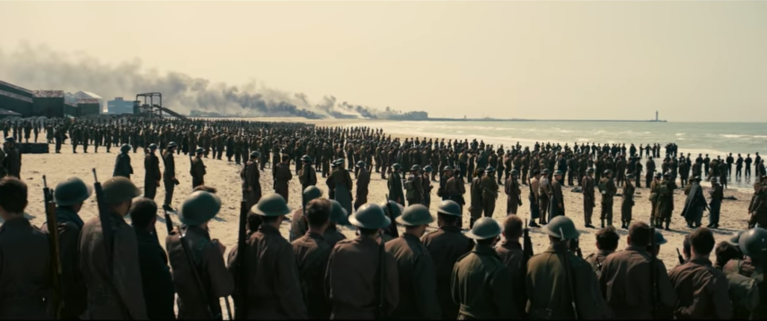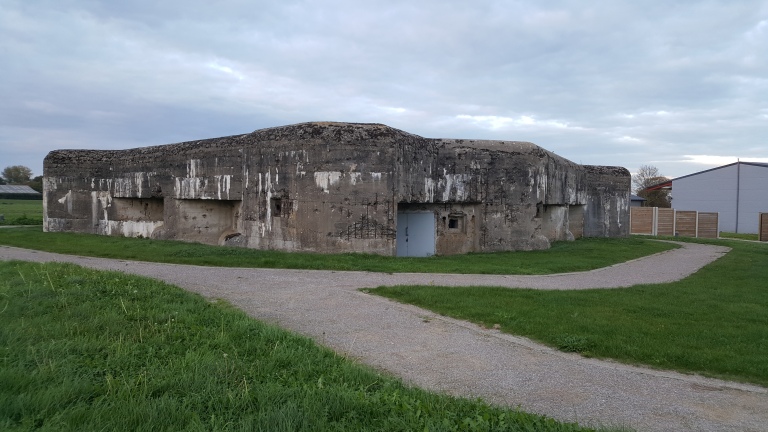EARLIER this year Chris Nolan’s spectacular wartime drama ‘Dunkirk’ stunned movie fans with its depiction of the dramatic events of 1940 when the Allied armies were plucked to safety from the beaches of northern France during the opening stages of the Second World War.
I watched the movie in the IMAX theatre on Parnell Street in all its 2D glory and, like most of the audience, was amazed by its brilliance. Having recently crossed the $500 million mark in cinemas across the world it is now widely considered an Oscar contender.
It tells the true story of what happened after Hitler’s armies had, in just a few short weeks, overrun France in May 1940. By trapping parts of the defeated French army and most of Britain’s expeditionary force into a narrow corridor along the French and Belgium coasts the Germans were on the verge of a great victory that could have seen both countries knocked out of the war.

The famous ‘Mole’ as depicted in the movie Dunkirk…
As the German noose tightened, the desperate Allied armies were forced back into a shrinking perimeter around the town of Dunkirk from where it was decided to launch a desperate bid to evacuate the troops.
Over nine days, between May 26 and June 4, a staggering total of 338,000 troops escaped from under the noses of the advancing Germans in an operation that is still remembered today as the ‘miracle of Dunkirk’.
It saved Britain’s army from annihilation and allowed them to recover and eventually fight back.

And as it is today.
As fans of the film know, Nolan tells the story of Dunkirk from the perspectives of the various participants who found themselves caught up in the ensuing chaos. In three overlapping time frames we see the young soldiers desperately trying to escape from the beaches in a story told over the course of a week while one of the volunteer crews that was part of the famous flotilla of ‘Little Ships’ that braved bombs and bullets to save the army is told over one day. Overhead, the gladiatorial Spitfire pilots are depicted holding off the might of the Luftwaffe in one hair-raising hour in the war-torn skies over the beaches.
It’s a technique that works, and as well as introducing a younger audience to one of the key moments in world history it also shone a light on this overlooked coastal town that was once in the grip of the world’s attention as Britain and her allies held their breath. And, for others, including myself, it was enough to inspire a visit to the very place where it all happened.
It requires a bit of travelling to get there from Ireland. There are direct ferry services from Britain’s Dover but if you’re flying in, the nearest airports are Brussels (Zaventem) and Paris (Beauvais), which are both equidistant away, and then it is still a two-hour rental car drive.

The beaches to the west of the town where troops gathered.
And truth be told, even when you finally get there, there is not a whole lot to recommend to the casual visitor. The town is blighted by an industrial port to the west and even though there are good wide stretches of sand, on a cold autumn day it is frankly a bit bleak. Under grey skies there is the air of a forgotten resort town that has long since seen better days. The small hotels and seaside apartment blocks are peeling paint while the few cafés are shuttered up and closed for the winter. There were just a few well-clad locals about, stoically walking their dogs on the wind-swept beaches that stretch off into the distance.
But for the history buff there is much to see and do here in Dunkirk. Even though the town itself was rebuilt after it was effectively flattened by bombing during the war, there is still evidence of the fighting that remains to this day.

And as depicted in the movie.
There is the bullet-scarred St Eloi’s church which is worth visiting for its great views over the surrounding countryside and the Dunkirk Memorial in the town cemetery where most of those who died during the evacuation are buried. There is another memorial down at the seafront near the famous ‘Mole’, the 800-metre long breakwater that stretches off into the sea at the east end of the town.
This is where the majority of the troops were eventually rescued by the Royal Navy over the nine days of the operation that was codenamed Dynamo. Most of the iconic images associated with Dunkirk feature long lines of men, zigzagging across the sands, calmly awaiting their turn to be picked up by the flotilla of Little Ships that had come to their rescue, but it was actually here, on this narrow concrete finger pointing out into the sea, where most of them would find salvation.
It plays a central role in the story depicted in the film and today it pretty much exists as it did 80 years ago when thousands of troops packed onto it, scrambling to avoid the explosions and gunfire from the screaming Stuka dive bombers.

The beaches in 1940.
The last wooden section collapsed into the sea during a storm in the 1970s but it was faithfully recreated for the scenes in the movie.
It is now home to fishermen angling to catch their supper in the cold grey seas but looking back at Dunkirk from the end of the Mole, it is possible to imagine the inferno that engulfed the town during those traumatic days.
There is even more evidence of the fighting lying half-buried in the sands just off shore. At particular times of the year, at low tide, it is possible to walk out to several wrecks of some of the ships that failed to make it back across the sea to safety. One of the most poignant is the wreck of the MV Crested Eagle which was forced to beach when it was disabled by a brace of bombs after it had picked up hundreds of troops from the Mole.
It was turned into a raging inferno and despite the best efforts of its heroic captain over 300 men lost their lives on the converted paddle steam ship as it ran aground just off the coast at the neighbouring suburb of Zuydcoote, a few miles north-east of Dunkirk.

One of the displays in the Operation Dynamo Museum.
The rusted skeleton of the ship is still lying partially covered by the sand and even though I had planned my visit around one of the dates when the tide would be at its lowest point, the tail end of Storm Ophelia put paid to this plan as I realised when I woke that morning to the sound of crashing waves.
Instead I used the opportunity of the inclement conditions to take shelter in the well-appointed Operation Dynamo museum located in Bastion 32, the former headquarters of the beleaguered French high command who oversaw the evacuation from deep within its maze of concrete tunnels.
The museum doubled in size to allow for more Second World War relics to be displayed ahead of the movie’s release and while previously it would have welcomed around 100 tourists a day it has seen numbers swell at least 300 daily. (Note the museum is closed now until April 2018).

The engine of a lost Spitfire in the museum.
It is well stocked with a wide variety of artefacts, models and uniforms associated with the operation. It also tells the story of the difficult years of occupation under the Nazis and the eventual liberation by Canadian and Czech troops that was only delivered at the end of the war as the Germans defiantly held out.
For those with a few extra days on their hands and who want to explore the Dunkirk story a bit further, there are other sites associated with the battle located outside the town. This is where some of the heroic rear-guard actions were fought in a desperate bid to stop the Germans from overrunning the beaches.
One of these is the hill town of Cassel, 40km inland, a strategic highpoint overlooking the surrounding low-lying countryside.

The casement at Cassel
A garrison town from the time of the Romans, it is difficult now to imaging the ferocity of the fighting here where the Gloucestershire Regiment was all but annihilated as they fought to buy time for their comrades on the beaches. But just outside the pretty town is a reminder of the sacrifices these soldiers made. On the road back to Dunkirk there is a well-hidden concrete bunker where a score of soldiers held off the Germans for days until their food and ammunition ran out.
It was an extreme act of selfless heroism and while many of these men would spend the rest of the war in a German prison camp their actions allowed their comrades to escape and live to fight another day. And eventually they would return, four years later, to lead the fight to free Europe from the tyranny of evil.

